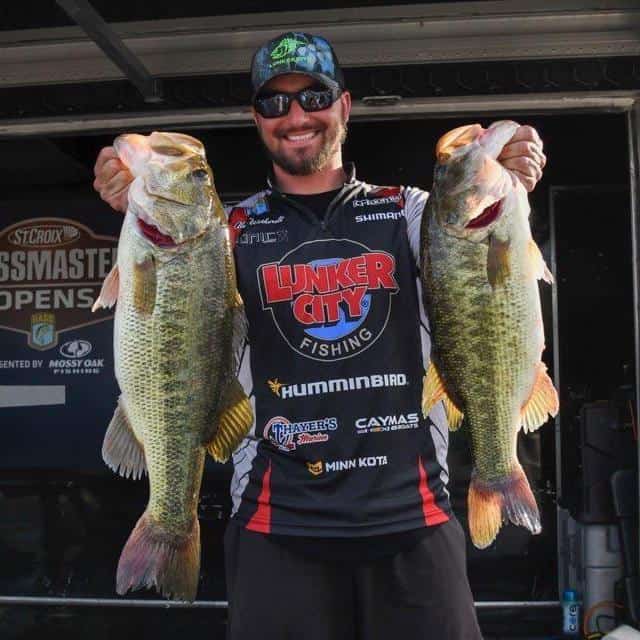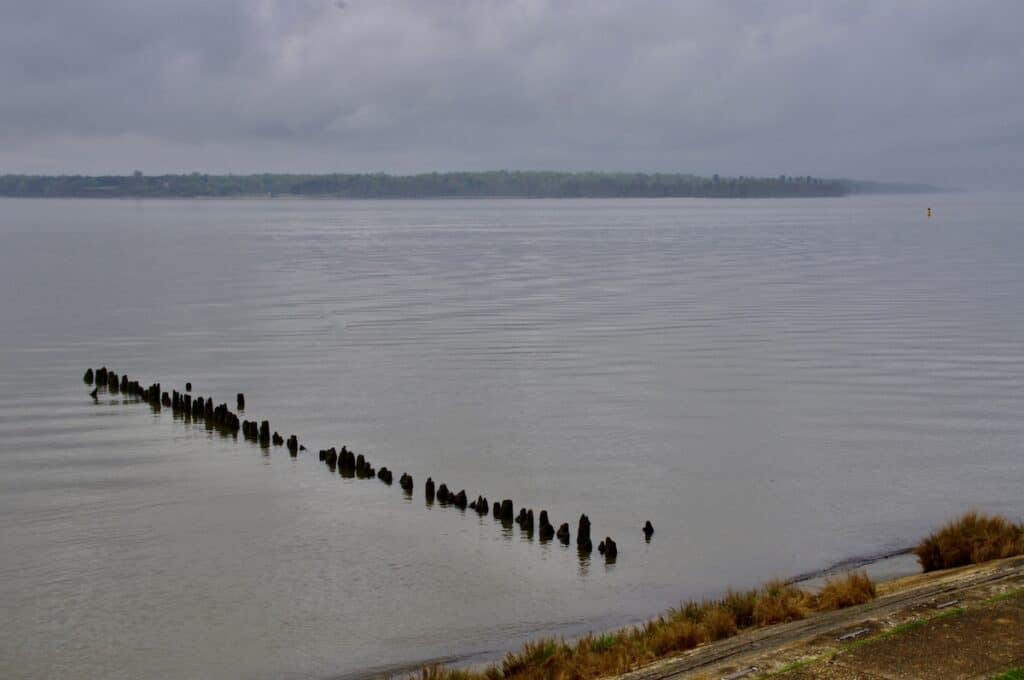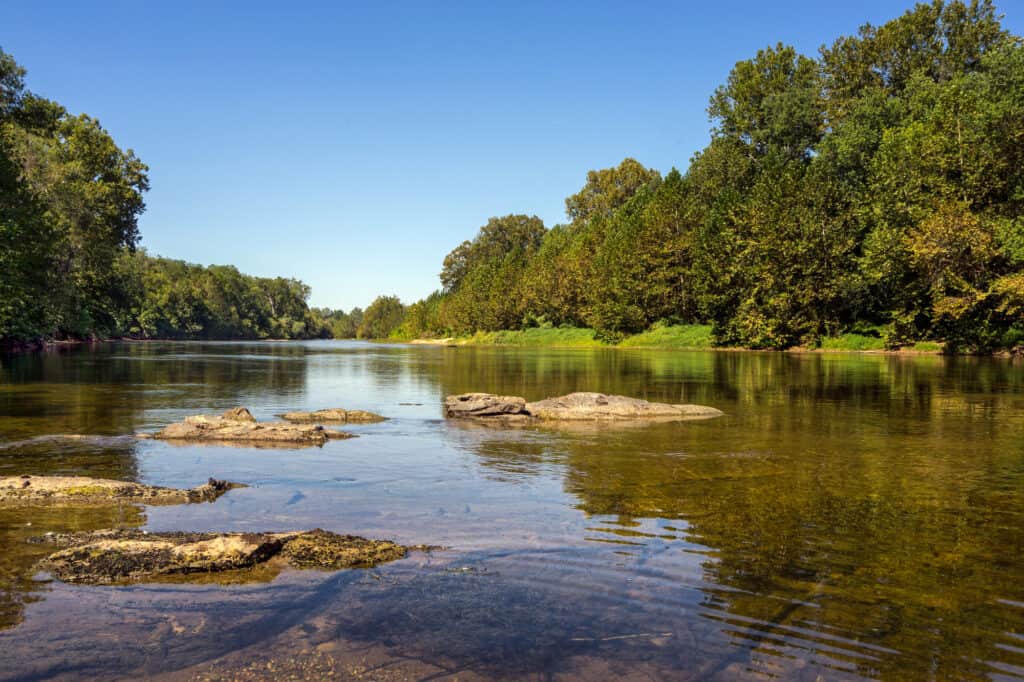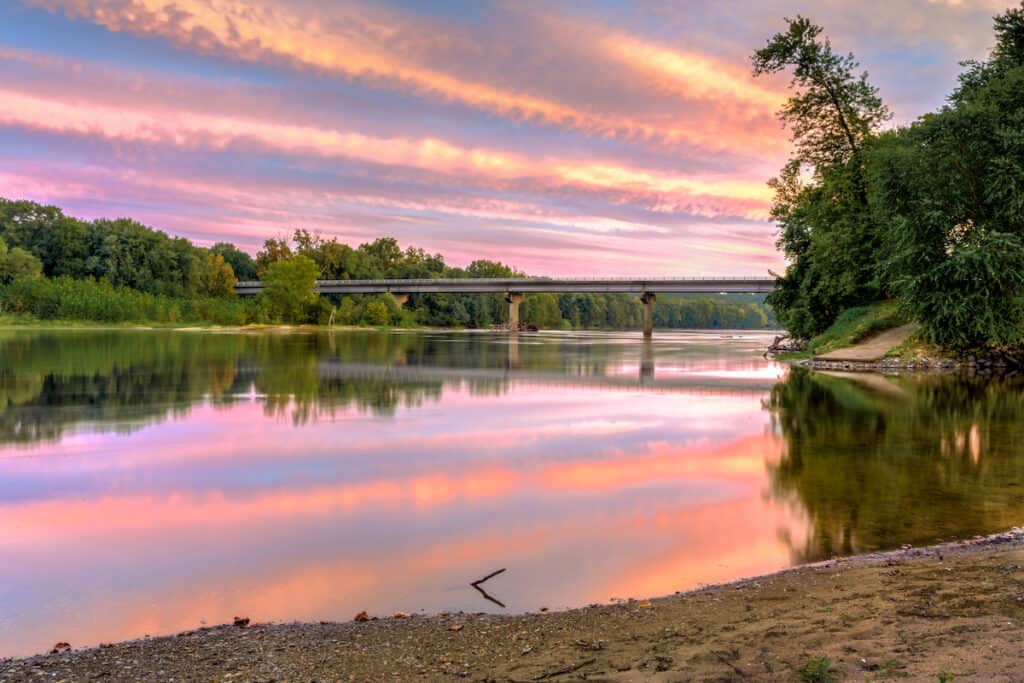Each section of the James River offers something special. Hard-fighting river smallmouths, elusive muskellunge, monstrous blue catfish, sporty stripers and trophy largemouth bass are all on the table, depending on which part of the James you cast your line into.
The longest river in Virginia, the James flows 348 miles from the Appalachian Mountains to the Chesapeake Bay. The river’s humble origin is in the tiny mountain town of Iron Gate, where the Cowpasture and Jackson rivers meet to form the headwaters of the James.
The James River is miles wide by the time it reaches the Chesapeake, having gained strength as it is joined by waters from other rivers including the Maury, Appomattox and Chickahominy.
The lower James River is also quite different from the upper and middle James. The dividing line is in Richmond, where the fall line section of the James River marks the uppermost extent of tidal influence.
Tidal James River
The James River’s tidal portion extends from the river’s mouth up to the fall line in Richmond, a stretch of about 100 miles. This section includes abundant weed beds, broad flats, flooded cypress trees, and numerous feeder creeks and tributaries.
The tidal James offers a range of fishing opportunities throughout the year, including seasonal striper runs, trophy blue catfish, and year-round largemouth bass fishing. Panfish including crappie, white perch, bluegill and yellow perch (known locally as ring perch) are also available.
Fishing the tidal James River also requires caution and awareness of the tides. For example, boating up a shallow feeder creek at high tide and trying to get back out at low tide can get you in trouble.
But the rewards are undeniable.
James River Bass Fishing
The tidal James River offers some of Virginia’s best bass fishing. This area is a tournament favorite, and has played host to numerous Bassmaster events over the years.
Anglers can expect to catch the occasional smallmouth or spotted bass here, but largemouths are by far the dominant black bass species in the tidal James. Largemouth bass up to 4 pounds are abundant, and if there’s any place in the state where you’re likely to catch an 8-pounder, it’s here.
Largemouths can be caught anywhere in the tidal James, but the best area is above the Appomattox River. Below that, salinity is higher, and there’s better bass fishing in tributaries like Herring and Powell’s creeks and the Chickahominy River.
Spring is a particularly good time to be bass fishing on the lower James River. Bass key in on baitfish this time of year, with seasonal runs of shad, herring and white perch bringing plenty of food to their doorstep.
Swimbaits and jerkbaits around emerging grass beds are the way to go.
Mid- to late April is typically the peak of the spawn for tidewater largemouths, and you can catch a lot of fish targeting shallow cover like fallen trees, dock pilings and cypress trees this time of year.
Following the spawn, deeper channel edges and drop-offs come into play.
Tides have a major influence, often bringing bass close to shallow structure at high tide and pushing them back to deep areas at low tide. Many anglers find the fishing easiest around a slack tide, but rising and falling tides also get baitfish moving and can prompt bass to feed.
In fall, look for bass to return to shallow areas as they follow migrating baitfish into the backs of creeks from main river flats. Spinnerbaits, poppers and small crankbaits are all great fall lure options.
And bass fishing does not end with the arrival of winter. When it’s cold out, warm water discharges attract a lot of fish. Try the barge holes around Dutch Gap near the Chesterfield Power Station’s discharge.
On sunny winter days, head to shallow flats, which are quickly warmed by the sun. Jigs and creature baits worked slowly through shallows can be excellent.
James River Catfish
The tidal James River has become one of Virginia’s best catfish waters. While channel catfish have always been abundant in the river, recent years have seen a blue catfish explosion, both in terms of size and numbers.
Blue catfish were first stocked in the lower James River in the 1970s, but it took decades for the fishery to really develop. The 50- to 80-pound fish that anglers can catch here today were unthinkable as recently as the 90s. These days, headline-making blue cats are the norm.
Massive blues prowl the lower James River’s expansive flats, usually relating to some kind of structure like channel edges and bends, scour holes, and tributary mouths. They often shelter behind current breaks, waiting for the tide to bring an easy meal.
And while big catfish do lurk in deep water in the 30- to 50-foot range, many giants are caught surprisingly shallow. Some of the best catfish fishing takes place in less than 15 feet of water.
Unlike channel cats, big blues don’t readily gulp down dough balls and stink baits. Cut bait is the best offering, and most anglers fish it on some variation of a Carolina rig with a no-roll sinker and an 8/0 or 10/0 circle hook.
Shad make the ideal cut bait, and many local cat anglers start their day by catching shad using cast nets.
Make sure you hone your baitfish identification skills; there’s currently a moratorium on having blueback herring or alewife in your possession on the tidal James River.
When it comes to blue cats, big bait equals big fish. The ideal cut bait size is about half of an 8- to 12-inch shad. In a pinch, the eels available at many bait shops in the area will do the trick.
You might catch blue catfish in any season, but experienced James River catfish guides typically favor winter, particularly early and late in the season. More often than not, the best time to fish is during the last two hours of an outgoing tide and the first two hours of an incoming tide.
James River Striper Fishing
The annual migration of striped bass in and out of the Chesapeake Bay and its tributaries is a much-anticipated event. When these fish reach tidal rivers like the James in spring, anglers are ready.
Fishing for this species is closed from April 1 to May 15 to allow them to spawn successfully, so your best bets are to target stripers as they enter the river in March or as they head back downriver from mid-May into June.
Early and late in the season, there’s great fishing right around the mouth of the river near the James River Bridge. Many anglers cast topwaters, bucktails, large curlytail grubs, and live baitfish around the bridge pilings.
The James River Fishing Pier, which extends out into the river parallel to the bridge, is also a prime spot for shorebound anglers in early spring.
As stripers make their way up the river, they usually gravitate to rocky structure.
Farther upriver, there is also excellent striper fishing around the I-295 Bridge in Richmond. Near this crossing is a good area to fish right when the season opens in mid-May, after which the best fishing gradually makes its way back down toward the mouth of the river.
Large numbers of striped bass return to the James River in the fall, offering another shot at these anadromous fish.
The James River Pier once again is a seasonal hotspot in this later season, especially for “schoolie” stripers weighing 10 pounds and under.
Fishing with topwaters is often excellent from dusk until after dark in fall, especially in areas where lights attract schools of baitfish. The Benjamin Harrison Memorial Bridge is a top draw for stripers and anglers.
During the day, try drifting live shad on flats near the river channel.
Catch More Stripers
The Best Striper (Rockfish) Fishing Spots in Virginia
Crappie Fishing
Anglers find some of Virginia’s best crappie fishing in its tidal rivers, including the James and major tributaries like the Chickahominy. Many areas of the lower James River harbor vast numbers of black crappies measuring 11 to 13 inches.
James River crappie fishing is often at its best in the dead of winter. While Virginia’s lake-dwelling crappies are still huddled around deep brush piles, you should almost always be able to find their James River counterparts around predictable shallow cover.
Key areas are vertical structures, like bridge and pier pilings, with deeper water (around 12 feet) nearby. One of the best places to start is the old river channel and barge pit near the Chesterfield Power Station’s warm water discharge.
The winter crappie bite only really slows down when the water temperature falls below 40 degrees. Otherwise, you can expect consistently good fishing using both jigs and minnows.
Crappie fishing in the James River continues to excel in springtime. The spawn takes place in April. By then, shallow creeks, sloughs and backwaters provide excellent fishing, often in just 2 to 5 feet of water.
As a general rule, crappies don’t like strong current, and you can use that factor to greatly reduce your search area. The Turkey Neck and Jones Island areas are excellent, with quiet backwater areas loaded with brush and timber.
When there’s more current present, crappies will take any opportunity to shelter behind a break in the flow. Look for them on the slack side of boulders, trees, sunken barges and docks.
Shad Fishing
The spring shad run on the James River offers a brief window during which anglers can catch these hard fighters, sometimes called “poor man’s tarpon.” Shad start running in March and peak in April.
Hickory shad are the primary target, and they surge up the river in huge numbers. Many make it as far as Lynchburg, but the Richmond area is the epicenter of shad fishing, right at the upper end of the tidal portion of the river.
Shad darts are the traditional lure for these fish, though spoons are effective, and some fly anglers also catch them using streamers.
Shad don’t usually feed actively when spawning, but they’re easily provoked into a reaction strike.
Shad typically hold close to the bottom, so add a sinker or two to your line to keep the bait down low in the water column.
Anglers can catch shad right from the bank at most public access sites in the Richmond area.
Keep in mind that you must release unharmed any shad species other than hickory shad. You can identify a hickory shad by its protruding lower jaw, which differentiates them from American shad.
Middle & Upper James River
Fishing the James River above the fall line is a very different experience than fishing below it. Above the influence of the tides, the James is a classic East Coast river, made up of rocky riffles, broad runs and deep pools.
Smallmouth bass are the dominant species, along with catfish. Panfish such as bluegill, redbreast sunfish, and rock bass are also common.
The river is popular for float trips, and many sections are easy to wade, making it a prime destination for bank and boat anglers alike.
The section from Richmond upriver to Lynchburg is considered the middle James River, and the upper James River is from Lynchburg up to the river’s headwaters.
James River Smallmouth
From the 14th Street bridge in Richmond all the way up to the confluence of the Jackson and Cowpasture rivers in Botetourt County, the James River provides truly exceptional smallmouth bass fishing.
You’ll catch the occasional largemouth in the middle James, too, especially in the Richmond area right around the fall line, but smallmouths are far and away the dominant species. The river’s rocky habitat is perfect for them.
Smallies in the 10- to 14-inch range are most abundant. That being said, the river is also more than capable of producing trophy smallmouths. Electrofishing surveys by the Virginia DWR invariably turn up fish measuring 20 inches or more.
Great fishing spots on the James River are too numerous to list, and ever-shifting currents and bottom topography are such that the river is never precisely the same from one year to the next.
The increased popularity of bass fishing on the river also makes it advantageous to target off-the-beaten-path spots. A good rule of thumb is that fishing improves as you head upriver. The 90 miles of the James River above Lynchburg are especially good.
The Horseshoe Bend and Buchanan areas offer excellent smallmouth bass fishing on the upper James River. The James River Gorge area below Glasgow is also a great stretch, albeit one with some challenging rapids.
Around Lynchburg, the James is increasingly controlled by dams, though tailwaters below the Holcomb Rock Dam, Reusens Dam, and Scotts Mill Dam each provide some good bass fishing.
The best time of year to fish the middle and upper James for smallmouth bass is arguably summer through early fall, when water levels are the lowest, making the river easy to wade. Tube jigs and curlytail grubs in crawfish colors are great baits, and streamers produce good results for James River fly fishing.
Target smallmouths around any noticeable current break, especially boulders, bridge pilings and laydowns. Bass often seek shade beneath ledges and weed beds during the hottest part of the day, and hunt at the upper and lower ends of pools in the morning and evening.
Channel and Flathead Catfish
The middle and upper James River offer tremendous catfish angling opportunities. But keep in mind that the river is very different above the fall line than it is below.
Anglers do catch some big blue catfish in the Richmond area, but blue cats become increasingly rare farther upriver. Instead, anglers have a prolific channel catfish population and some very large flatheads to keep them occupied.
Channel catfish are among the most widespread fish in the James River. They commonly weigh 1 to 4 pounds, but anglers catch plenty of channels weighing over 10 pounds every year.
DWR surveys suggest channel cat numbers are highest from Richmond to Lynchburg.
Flatheads are also widespread, but certain river sections regularly produce more and bigger fish. The general area around Lynchburg tends to be the best, with the potential for flatheads up to 25 pounds.
Tailwater areas below dams are some of the best places to find flatheads, which typically spend their days in the deepest available holes and emerge to hunt on flats after dark.
Night fishing with live bluegill or cut bait is the best approach, with summer being prime flathead season.
In the Richmond area, quite a few flatheads are caught in the stretch from Bosher’s Dam downriver to the Powhite Parkway. Expect a mixed catch of channel and flathead catfish here, with the occasional blue.
Overall, catfish numbers are higher in the middle James River than the upper river, which has a higher gradient and fewer deep, still pools.
Channel catfish often bite chicken livers, nightcrawlers and dough baits at the upper and lower ends of pools.
James River Musky Fishing
No fish in the James River is more challenging to hook and land than the muskellunge. Even so, the upper 90 miles of the James River above Lynchburg might just be the best musky water in the commonwealth.
DWR electrofishing surveys have included fish measuring up to 45 inches. Muskellunge from the James River also provide broodstock for statewide muskie stocking operations.
Muskies are large, solitary predators, and they are most common in the upper James River’s deepest pools, with the 4-mile stretch from Springwood to Buchanan being the most popular among muskie hunters. Catching them is a matter of persistence and patience.
Oversized topwaters and in-line spinners are among the most widely used lures. Both tactics result in some solid hooksets in spring and early summer. May and June are prime musky months.
Fall is also a good season to target muskellunge. This time of year, large swimbaits and jerkbaits are effective as muskies look for the biggest meal they can get as winter approaches.
Planning Your Trip
The James River offers year-round fishing opportunities, though the warmer months are generally the best times to fish the river, particularly its upper sections.
Tidal portions of the James River offer great winter and early spring fishing opportunities as well.
Flowing eastward across almost the entire state of Virginia, the river passes through or near several of the largest cities in the commonwealth, making it easy to get to from any direction. Multiple interstates cross the James River, including I-295 in the tidewater region, I-95 in Richmond, and I-81 on the upper river.
You can readily find bank and boat access to most James River fishing spots available on each section of the James River. Access points are too numerous to list in their entirety, but below are some of the better spots to launch a boat or fish from shore.
Tidal James River Access
Norfolk’s Willoughby Boat Ramp and the Huntington Park Municipal Boat Ramp in Newport News are a couple of the more popular places to launch a boat near the mouth of the James River.
Several public piers are also available in this area, including the James River Fishing Pier.
Farther up on the freshwater portion of the tidal James River, access is abundant. Chickahominy Riverfront Park offers a campground, excellent launch facilities, and bank access on the Chickahominy River near its confluence with the James.
Continuing upriver, Deep Bottom Park and Osborne Park each provide boat ramps and fishing piers on what is arguably the best stretch of the tidal James River.
The nearby Dutch Gap Boat Landing is the closest launch site to the warm water discharge at the Chesterfield Power Station.
The boat ramp at Richmond’s Ancarrow’s Landing is just below the fall line, making it the final launch site on the tidal James River.
Richmond Area Access
The nine miles of the James River that flow through Richmond is often referred to as the “fall line section.” The river drops 100 feet throughout this section, which runs from the base of Bosher’s Dam to the 14th Street bridge.
This section’s rocky, tumultuous nature limits its accessibility to large boats, but it is renowned for its canoeing and kayaking. The James River Park System collectively manages dozens of access points.
The Pony Pasture area is one of the most popular spots to fish the river in Richmond.
The stretch known as Huguenot Flatwater is the most tranquil in the area, making it ideal for paddling.
Middle James River Access
The middle James River, from Bosher’s Dam upriver to Lynchburg, stretches 130 miles and offers ample access. Two state parks in this section (Powhatan State Park and James River State Park) each provide campsites, cartop boat launches, and excellent bank fishing access.
State boat launches are located at Howardsville Boat Landing, Hardware River WMA and James River WMA.
Additional launches and landings are at Watkins Landing, West View, Cartersville, Columbia, Bremo Bluff, Scottsville, Midway, Wingina and Joshua Falls.
Upper James River Access
The 90 miles of the James River from Lynchburg up to the confluence of the Cowpasture and Jackson rivers near Iron Gate are among the most scenic on the river and offer some of its best fishing and paddling.
Bank fishing is available in Lynchburg at Percival’s Island Natural Area and a few miles upriver at Monacan Park. The latter site also includes boat launch facilities.
Continuing upriver, launching is available at Reed Creek Landing just below Big Island Dam and at the Hunting Creek and Snowden boat ramps above the dam.
The Glasgow Canoe Launch is a great spot at the confluence of the James and Maury rivers.
The area above Glasgow is exceptionally popular for paddling. It offers numerous canoe and kayak landings, including put-in and take-out sites at Alpine, Arcadia, Buchanan, Springwood, Horseshoe Bend, Craig Creek, Gala, Glen Wilton and, finally, Iron Gate.
Of the above, only the Springwood and Horseshoe Bend sites have concrete ramps; all others are shoreline access only. More information on this section is available through the Upper James River Water Trail.




